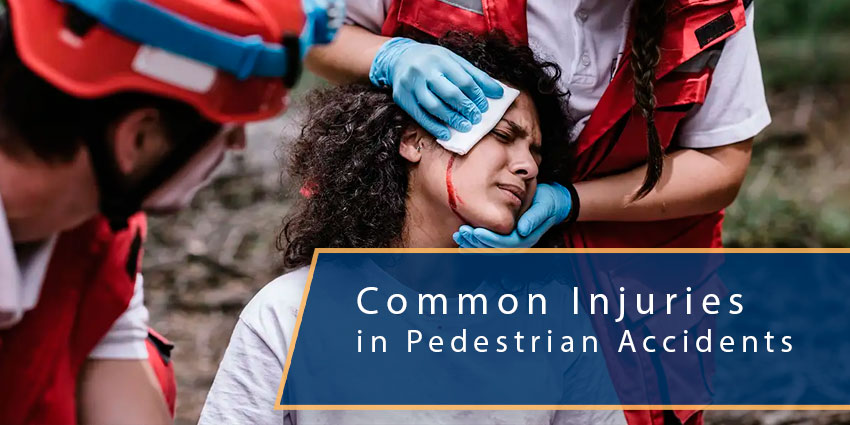Pedestrian accidents sadly occur across the U.S. every day. Over the past decade, the number of people struck and killed while walking has increased by 45%. This equates to more than 17 pedestrian deaths per day.
Injuries to pedestrians can range from minor to catastrophic. These injuries are almost always life-changing.
In the article, we’ll cover the most common types of injuries to pedestrians. We will also discuss how to file a personal injury claim.
Table of Contents
What Are the Most Common Injuries in Pedestrian Accidents?
Soft Tissue Damage
Soft tissue injuries damage muscles, ligaments and tendons, such as bruises, tears, dislocations, sprains and lacerations.
Many soft tissue injuries recover naturally over time but can cause serious discomfort and restricted movement. Soft tissue victims may struggle to complete everyday activities and go to work. They may also have scarring and other long-term issues that disrupt their lives.
Traumatic Brain Injuries
Traumatic brain injuries (TBI) are caused by sudden, violent blows or jolts to the head or body, or an object going through the head. They are one of the most common types of head injuries.
Traumatic brain injuries is a term that covers a wide range of brain injuries, including:
Closed Brain Injury
Closed brain injuries are caused by nonpenetrating accidents and are one of the most severe injuries one can suffer. For example, in a pedestrian accident, the victim’s head may have hit the vehicle and the ground. This can cause rapid movement in the brain, causing bruising and tearing of blood vessels and brain tissue.
Even if no contact was made between the head and an object, the brain might still suffer a sudden and violent movement inside the skull in an accident.
A traumatic brain injury is often life-changing and tends to result in a significant settlement if the victim wasn’t to blame.
Penetrating Brain Injury
Penetrating brain injuries are caused when the skull and brain are pierced. In a pedestrian accident, the head may be penetrated by debris or a colliding vehicle.
Broken Bones and Bone Fractures
Bone fractures and breaks are caused when a bone is put under pressure it cannot bear. There are various types of breaks and fractures, commonly caused by direct hits to the body.
In a pedestrian accident, the victim may suffer a break or fracture due to the collision with the vehicle or the impact with the road or sidewalk.
Bone breaks tend to heal over four to eight weeks (depending on age and health) but may result in a loss of movement and pain for the rest of your life.
Common broken bones include:
- Broken wrists
- Broken ankles
- Fractured hips
- Broken legs
- Broken hips
- Broken jaws
- Skull fractures
- Broken collarbones
Spinal Cord Injuries
Spinal cord injuries are one of the most severe types of pedestrian injuries and are caused by sudden, traumatic blows, movements or twists to the spinal cord. This force damages the spinal cord and nerves at the end of the spinal cord (cauda equina).
Victims are likely to suffer life-changing symptoms, including disability and loss of strength, function and sensation to body parts below the site of injury. They will likely require extensive rehabilitation and physical therapy.
Spinal cord injuries are sadly common in pedestrian accidents, as victims receive violent blows from fast-moving vehicles.
Spinal cord injury victims deserve to receive significant settlements that ensure they are financially supported for their new injury-affected future if they’ve been in an accident that wasn’t their fault.
Neck Injuries
Similarly, neck injuries are not rare after pedestrian accidents. Neck injuries may include:
- Whiplash
- Sprains
- Muscle or tendon damage
- Herniated discs
- Pinched nerves
- Bone fractures
Amputations
Amputations are injuries where the victim suffers a loss or removal of a body part, such as fingers, toes, hand, arm, legs or feet.
Amputations may be directly caused by an accident or surgically required due to complications such as infection or severely broken bones, or soft tissue damage.
Amputation patients will experience life-changing consequences, such as difficulties with movement, work and independence. Patients also may experience ongoing pain, phantom limb phenomena and emotional trauma.
Disfiguration
Disfiguring injuries are also a common type of pedestrian accident. Extremities such as eyes, ears and the skin are vulnerable to burns and lacerations that can cause long-term scarring, disfiguration and nerve damage.
Disfiguration may require surgery to reduce pain and improve self-esteem.
Internal Injuries
Violent blows to the body can also result in internal organ injuries. Anyone suffering the signs of internal injuries after an accident, such as blood in stool, abdominal pain and swelling, chest pains, changes in skin color, should receive medical attention immediately.
Such symptoms may suggest internal bleeding, which could be a sign of other catastrophic injuries – such as brain damage and organ failure.
Emotional Trauma
Not all pedestrian injuries are physical, and many victims will suffer lasting emotional trauma. Victims may require therapy and medication to help them recover.
Victims of the following types of mental health issues may be able to receive compensation:
- Post-traumatic stress disorder
- Anxiety
- Depression
- Self-esteem issues
Wrongful Death
Sadly, pedestrian accidents frequently result in deaths. In 2019, 6,205 pedestrian deaths occurred.
If a loved one has been killed in a pedestrian accident, you can file a wrongful death claim to recover damages for the expenses your family has suffered since the accident and for any future losses.
What Are the Common Causes of Pedestrian Accidents?
Negligent Drivers
Negligent drivers cause the majority of pedestrian accidents. This means the driver was at fault due to negligent behavior such as:
- Distracted drivers
- Using a cellphone
- Eating or drinking
- Adjusting the AC or GPS
- Talking to passengers in the backseats
- Speeding
- Ignoring traffic signals
- Ignoring pedestrian crossings
Drunk Driver
28% of all traffic-related deaths in the U.S. involved alcohol-impaired driving crashes. Over a million drivers are arrested every day for driving while drunk or using drugs. These deaths and accidents are preventable.
Sadly, pedestrian injuries are common consequences, as drivers fail to react to stop signs or cause accidents that spill over to the sidewalk.
Faulty Traffic Signals
When pedestrians walk over a pedestrian crossing, they expect the traffic signals to inform the oncoming traffic to stop. If these lights fail, the driver may hit the pedestrians.
Left Hand Turns
Left-hand turns are responsible for many pedestrian injuries as the drivers focus their attention on whether other cars are oncoming, rather than looking to their other side for pedestrians.
Pedestrian Negligence
26% of alcohol-related pedestrian accidents include drunk pedestrians.
Scooters and Bikes
E-scooters and bikes should not be traveling at speed on the sidewalk. Sadly, riders do ignore these laws and collide with pedestrians all too often.
What to Do if I’m Injured in a Pedestrian Accident?
If you’re injured in a pedestrian accident, you may be able to file a personal injury claim to recover the damages you’ve suffered.
A personal injury attorney can help you prepare the personal injury claim, negotiate with the insurance company, and recover the money you deserve.
Here’s what you should do if you’ve been injured in a pedestrian accident:
- Receive medical attention immediately for any injuries
- Collect the other driver(s)’s information
- Ask for a police report
- Contact a pedestrian accident attorney
- Do not admit fault
- Keep all doctor’s notes
- Keep all medical bill receipts and recipes of injury-related expenses
- File a personal injury claim, preferably with the support of a personal injury attorney
How Are Pedestrians Usually Hit?
Pedestrians killed in single-vehicle traffic accidents suffer their initial point of impact at:
- 84% at the front of the vehicle
- 1.6% on the left
- 2.7% on the right
- 1.6% at the back
- 9.9% other or unknown
Source: NSC Facts
Florida Pedestrian Accident Statistics
- Florida is the most dangerous state for pedestrian accidents, with 5,893 over the past decade.
- Tampa-St. Petersburg-Clearwater, FL is the 8th most dangerous location for pedestrian accidents in the U.S.
Source: SmartGrowthAmerica.org
Contact a Pedestrian Accident Attorney in Florida
If you’ve suffered an injury in a pedestrian accident, our Florida pedestrian accident lawyers can help.
We know that this is a tough time and we will do everything in our power to help you and your family. By taking care of communications and fighting the legal battle on your behalf, we’ll bring you the settlement you deserve.
Free Consultations
Personal Injury Attorneys McQuaid & Douglas have been providing exceptional legal assistance to Florida residents for personal injury claims for decades. Our consultations are compassionate and free of charge.
Personal Injury Attorneys McQuaid & Douglas is the personal injury and wrongful death division of Battaglia, Ross, Dicus & McQuaid, P.A. Our firm was founded in 1958 and is a U.S. News and World Reports Tier 1 Law Firm.
With decades of legal experience and resources, they are equipped to give you the best chance of receiving the compensation you deserve. Serving the state of Florida with offices in St Petersburg and Riverview, they are here for you.














